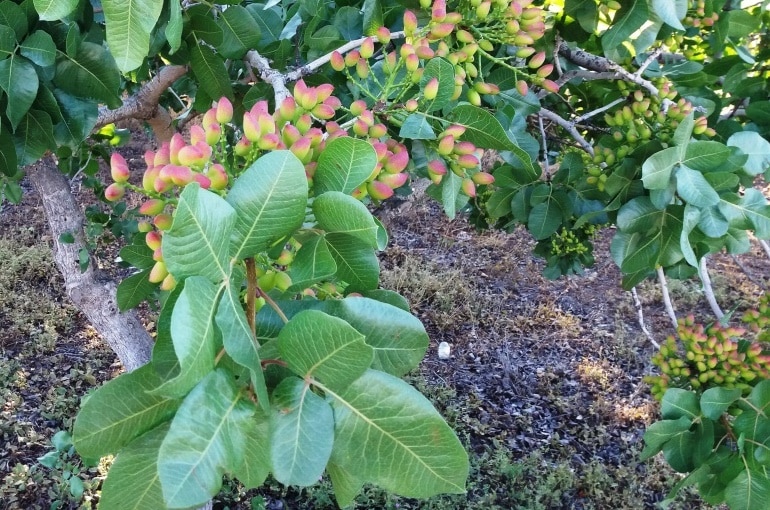Pistachio Tree Propagation and Pollination

This post is also available in:
This post is also available in:
![]() Español (Spanish)
Español (Spanish) ![]() Français (French)
Français (French) ![]() Deutsch (German)
Deutsch (German) ![]() Nederlands (Dutch)
Nederlands (Dutch) ![]() العربية (Arabic)
العربية (Arabic) ![]() Türkçe (Turkish)
Türkçe (Turkish) ![]() 简体中文 (Chinese (Simplified))
简体中文 (Chinese (Simplified)) ![]() Italiano (Italian)
Italiano (Italian) ![]() Português (Portuguese (Brazil))
Português (Portuguese (Brazil))
How to propagate and pollinate pistachio tree
Pistachio Tree Propagation
As it happens in many other popular fruit trees, the pistachio tree is propagated by budding. Professional pistachio growers benefit from a tree that is a combination of two different plant tissues, the rootstock and the scion. The rootstock is the lower part of the tree and produces the root system. The rootstock’s resistance to soil borne diseases (Verticillium wilt) is extremely important. The scion produces the upper part of the tree and of course determines the fruit’s characteristics. Both the rootstock and the scion must be carefully selected and each one of them may result in poor production. The scions are often budded onto the rootstocks after the latter have been planted into the pistachio orchards. In the United States, Kerman is the most popular female cultivar, which is pollinated most often by the male cultivar Randy. Pioneer Gold 1 and UCB-1 are hybrids rootstocks that are very popular due to resistance in Verticillium wilt.
Pistachio Tree Pollination
The natural pistachio tree pollination is made almost entirely by wind. Insects and bees do not help and rather deteriorate pistachio tree pollination. Pollen is transferred by wind from male trees to female trees. We have to place ideally 1 male tree in the center of every 7 female trees in small orchards. The position of the male tree must be in the center of every 7-9 female trees, so as to facilitate the dispersal of pollen in the air around the pistachio farm. In large pistachio orchards with 600 trees and more, farmers often place 1 male tree every 21 or more female trees.
Pistachio tree differs from other trees in that the male trees bloom first and the female trees bloom later. Lack of winter cold can create a major pollination problem. After a warm winter, due to incomplete interruption of dormancy, male trees bloom far earlier than the female trees. As a result, a great percentage of pollen is lost, something that results in decrease of fruit set and increase of empty nuts. Moreover, if during the bloom period there is no wind or rainy weather prevails, the natural pollination gets very difficult. In all these cases, artificial pollination is often used.
In a few words, we collect pollen from male trees and we store it in the fridge. We produce a pollen mixture and we disperse it in the pistachio farm only when the female trees have bloomed and only if the weather conditions are suitable (light wind and definitely no rain). Pistachio pollen can be easily collected from male trees. Male inflorescences are collected by hand once the anthers have opened, and they are immediately spread on a special paper in a cool, dry place. Then they are shaken for the next 2-3 days. The collected pollen is spread carefully on special material to dry and then is preserved in glass jars in the fridge. When we notice that the female trees have bloomed, pollen is usually mixed in a ratio of 1 part pollen to 3-4 parts of special powder and it is dispersed in the pistachio field in the morning through special equipment (sprayers). We repeat the same procedure every day for 4 days.
However, nowadays, quality orchard management has made artificial pollination look controversial. It is a labor intensive procedure that must be carried out only by experienced personnel under extraordinary situations. One the one hand, there are many cases in which increased quantity of pollen per stigma area caused excessive flower abscission after a certain point, and this resulted in low fruit set in pistachios after artificial pollination. On the other hand, there are findings suggesting that artificial pollination not only increased number of fruits per cluster and total yield per cluster but also improved nut size and kernel dry weight in some cases.
Read more on artificial pollination.
You can enrich this article by leaving a comment or photo of your propagation or pollination methods and techniques.
1.) Pistachio Tree Information
2.) How to grow Pistachio Tree from nut
3.) Starting a Pistachio Orchard
4.) Pistachio Tree Growing Conditions
5.) Pistachio Tree Propagation and Pollination
6.) Pistachio Tree Soil Conditions and Preparation
8.) Pistachio Tree Training and Pruning
9.) Pistachio Tree Fertilizer Requirements
10.) Pistachio Tree Water Requirements
11.) Pistachio Tree Harvest & Yields
12.) Pistachio Tree Diseases & Pests
Do you have experience in Pistachio Tree cultivation? Please share your experience, methods and practices in the comments below. All the content you add will be soon reviewed by our agronomists. Once approved, it will be added to Wikifarmer.com and it will influence positively thousands of new and experienced farmers across the world.








































































